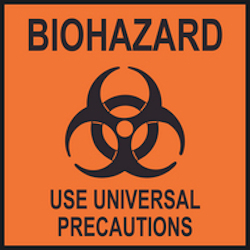Exposure Control Methods
Universal Precautions
The recommended infection-control concept called "universal precautions" advocates everyone's blood and body fluids be considered potentially infectious. It is an approach to infection control to treat all human blood and certain human body fluids as if they were known to be infectious for HIV, HBV and other bloodborne pathogens. This eliminates the difficulty in determining risk individually.

Bloodborne Pathogen Standard 29 CFR 1910.1030(d)(1) requires:
- Employees to observe Universal Precautions to prevent contact with blood or other potentially infectious materials (OPIM).
- Under circumstances in which differentiation between body fluid types is difficult or impossible, all body fluids shall be considered potentially infectious materials.
- Treat all blood and other potentially infectious materials with appropriate precautions such as:
- Use gloves, masks, and gowns if blood or OPIM exposure is anticipated.
- Use engineering and work practice controls to limit exposure.
Knowledge Check Choose the best answer for the question.
6-1. Which of the following infection-control concepts advocates that everyone's blood is considered potentially infectious?
You forgot to answer the question!
